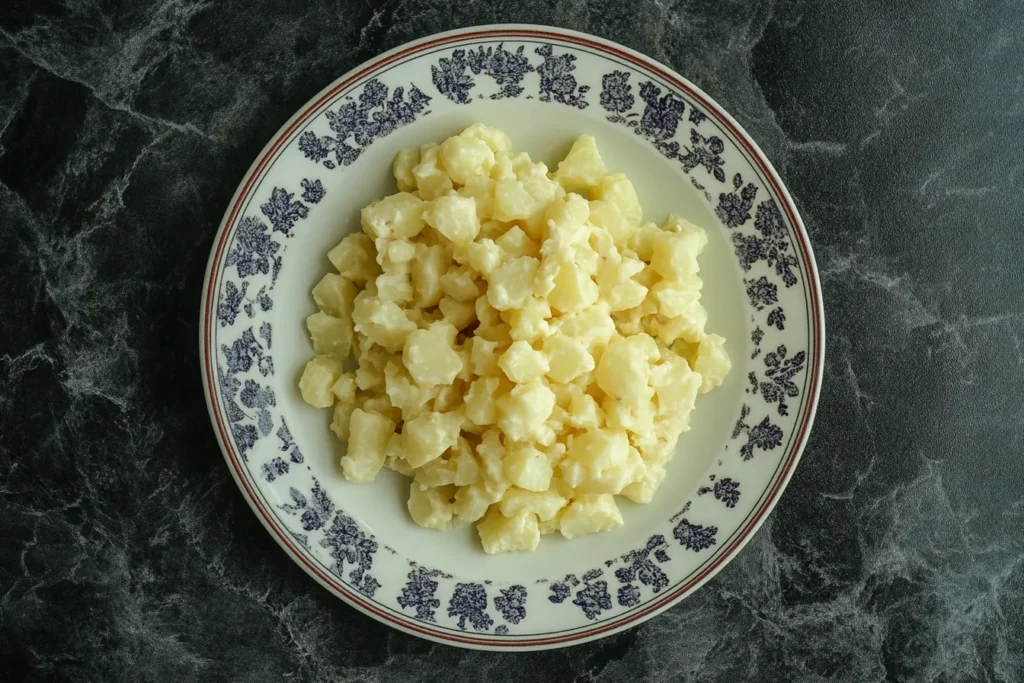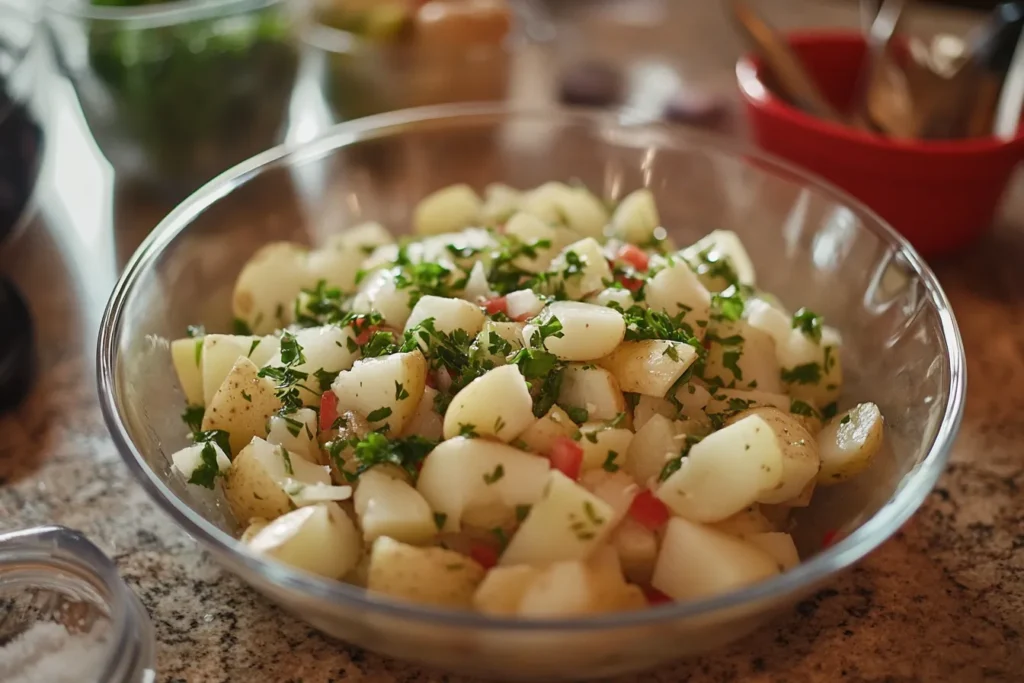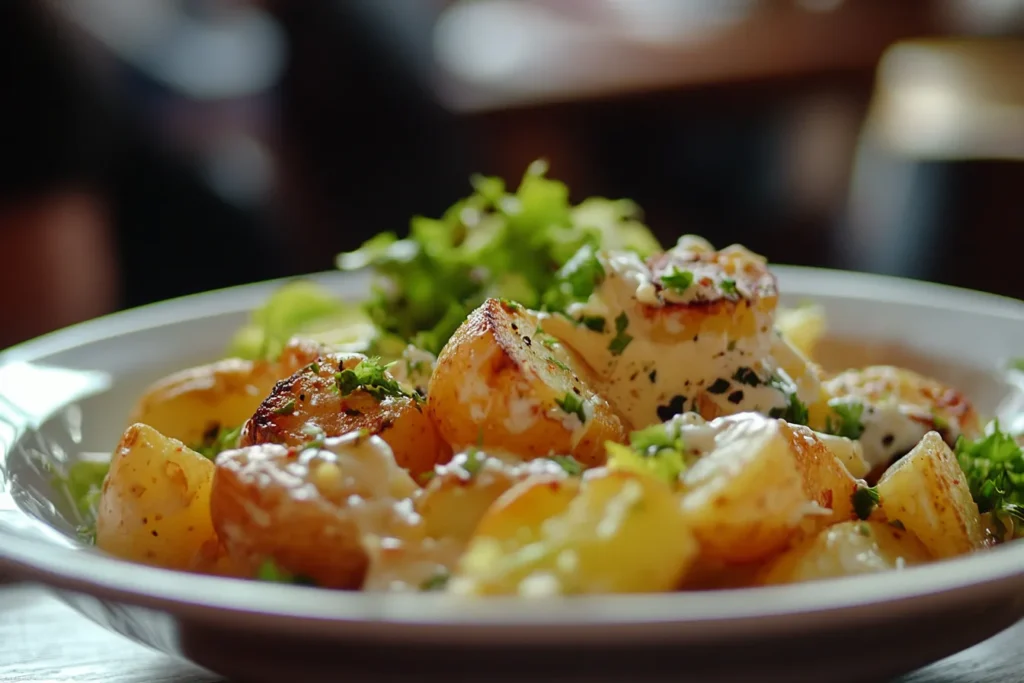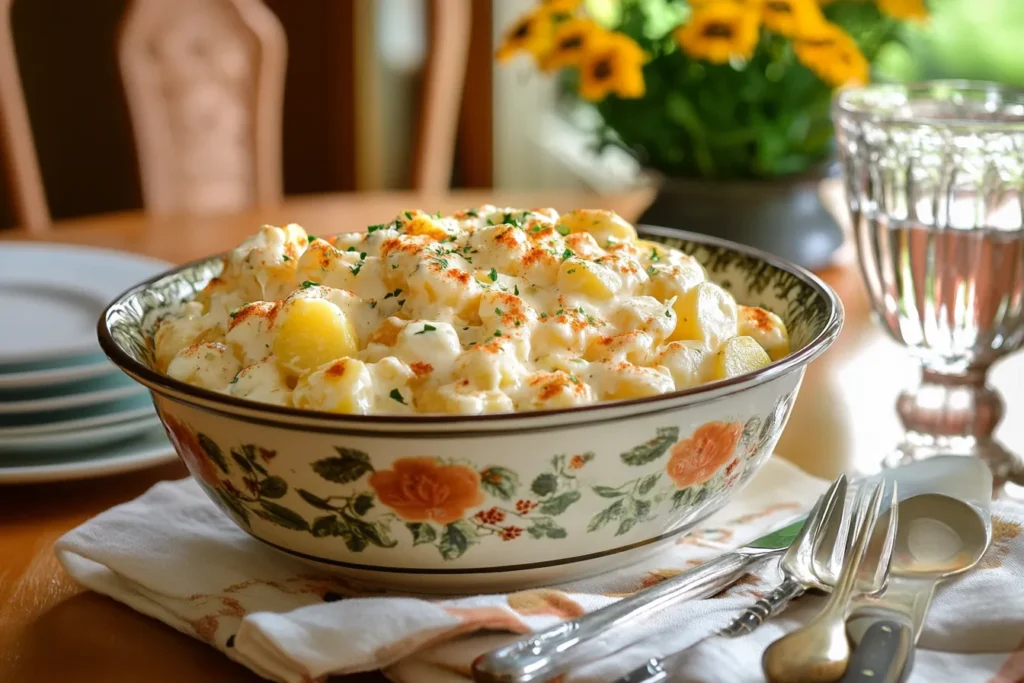Have you ever made potato salad, only to find it too mushy, overly bland, or just… not quite right? You’re not alone! Potato salad seems simple, but a few common mistakes can make or break this classic dish. Whether it’s choosing the wrong type of potato, overcooking them, or skipping key ingredients, there are a few things you definitely want to avoid. I’ve been there too—rushing through the process, only to end up with a bowl of disappointment instead of that creamy, flavorful goodness everyone loves. Don’t worry, though! With a little guidance, you can avoid these pitfalls and make a potato salad that’s the star of any table. Let’s dive into what not to do so you can get it just right every time!
List Of Contents
Choosing the Wrong Potatoes

Differences Between Waxy and Starchy Potatoes
Choosing the right type of potato is the first and most crucial step. Waxy potatoes, such as Yukon Golds or red potatoes, hold their shape well and provide a creamy texture, making them ideal for potato salad. On the other hand, starchy potatoes like Russets tend to break apart, which can lead to a mushy dish.
But why does this happen? Waxy potatoes have less starch and more moisture, which makes them perfect for salads where structure matters. Starchy potatoes, although great for mashing or baking, can absorb too much water when boiled, causing them to fall apart.
For those unsure about their choice, this helpful guide explains potato varieties in more detail and their best uses. Check out more recipes here.
Ignoring Potato Texture
The texture of the potatoes is what sets a great potato salad apart. Overcooking will make your salad sloppy and wet, while undercooking results in an unpleasantly crunchy bite.
To prevent this, cut the potatoes into even pieces before boiling. Regularly test their doneness by poking with a fork—they should be tender yet firm enough to hold their shape. Check out more recipes here.
Skipping the Salting Step
One of the most overlooked steps in potato salad preparation is salting the water. Adding salt while boiling infuses the potatoes with flavor from within, ensuring they aren’t bland at their core. Waiting to salt only after cooking will result in uneven seasoning, no matter how much dressing you add.
Adding Dressing Too Early
Why Dressing Too Hot Potatoes Leads to Sogginess
Timing is everything when dressing potato salad. Adding dressing to hot potatoes might seem efficient, but it can lead to soggy, oily results. As potatoes cool, they firm up and absorb flavors more gradually. If you dress them while they’re too warm, you risk a greasy salad instead of the creamy, flavorful dish you want.
Dressing Mistakes to Avoid
- Using too much mayo can overwhelm the dish, making it feel heavy.
- Neglecting seasoning in the dressing leads to bland results.
- Selecting the wrong type of dressing, such as overly sweet or unbalanced options, can clash with the natural potato flavor.
Instead, opt for a balance of creamy and tangy elements like mayonnaise mixed with mustard, vinegar, or yogurt for added depth. Check out more recipes here.
Not Balancing Flavors

The Role of Acidity, Sweetness, and Seasoning
Potato salad relies on a delicate balance of flavors. Acidity from vinegar or lemon juice cuts through the richness of mayonnaise, while a hint of sweetness, often from sugar or sweet pickles, rounds it out. Seasoning with salt and pepper is the final touch to ensure a cohesive taste.
Skipping any of these elements can result in a dish that feels flat or overly one-note. A good rule of thumb? Taste and adjust as you go.
Forgetting Fresh Herbs
Fresh herbs like dill, parsley, or chives are non-negotiable for a vibrant potato salad. Without them, your salad might lack the brightness that makes it stand out. They add a pop of color and a fresh flavor profile that pre-dried seasonings simply can’t replicate.
For more tips on herbs to enhance salads, check out this comprehensive list.
Overloading Ingredients
Why Too Many Add-Ins Can Overwhelm the Dish
While add-ins like eggs, bacon, or pickles can elevate your potato salad, going overboard can create a confusing medley of flavors. A good potato salad highlights the potatoes, not the extras.
Mismatched Textures
Balance is also crucial when it comes to textures. Combining too many crunchy ingredients, like celery and pickles, with soft potatoes can feel chaotic. Strive for harmony between smooth and crisp elements to keep the salad enjoyable.
Failing to Chill Properly
Why Potato Salad Needs Adequate Chilling Time
Potato salad isn’t just about flavor; temperature plays a critical role. Giving the salad enough time to chill allows flavors to meld and ensures it’s served at the refreshing temperature it’s known for.
Improper Storage
Storing potato salad incorrectly can lead to food safety issues and loss of freshness. Always keep it in an airtight container in the refrigerator, and avoid leaving it out at room temperature for more than two hours.
Technical Errors in Potato Salad Preparation
Creating the perfect potato salad requires not just attention to ingredients but also a precise method of preparation. Even seemingly small technical errors can significantly impact the taste, texture, and presentation. By focusing on the details, you can ensure your potato salad turns out flawless every time.
Not Peeling or Cutting Potatoes Correctly
Uniform Size and Peeling Techniques for Consistency
Consistency is key when preparing potatoes for a salad. Peeling might seem optional, but it often depends on the type of potato. Waxy potatoes like Yukon Golds have thin skins that can be left on for added texture, while starchy potatoes benefit from peeling for a smoother finish.
Cutting the potatoes into uniform sizes ensures even cooking. Uneven pieces can lead to a mix of undercooked and overcooked bites, which detracts from the overall experience. Precision here saves time and guarantees quality.
Cutting Before Boiling
Some may think cutting potatoes before boiling speeds up cooking, but this simple mistake can lead to waterlogged potatoes. Pre-cut pieces absorb more water during the cooking process, diluting the flavor and making the texture mushy.
Instead, boil whole potatoes or in large chunks, then cut them after they’ve cooled slightly. This method retains their structure and taste.
Overcooking or Undercooking Potatoes
Signs Your Potatoes Are Perfectly Cooked
The line between overcooking and undercooking is razor-thin. Overcooked potatoes disintegrate into a gluey mess, while undercooked ones are unpleasantly firm. How can you get it right?
- Use a fork to test doneness: the potato should slide off easily when pierced.
- Monitor closely as they cook—potatoes can go from perfect to overdone in just a minute.
For step-by-step guidance, this detailed cooking guide offers additional tips.
Testing for Doneness
Don’t rely solely on time-based cooking. Instead, test multiple pieces from the pot to ensure even cooking. This practice is especially important if you’re working with a mix of potato sizes or types.
Using the Wrong Mixing Tools

How Forks, Spoons, or Hands Affect Potato Integrity
The tools you use to mix the potato salad have a surprising impact on its texture. Using a heavy hand with a fork or spoon can cause the potatoes to break apart, resulting in a mushy salad. Conversely, mixing too gently may leave the ingredients unevenly coated.
To avoid this, use a wide, flat spatula or your hands to fold the ingredients together. This method is gentler and preserves the integrity of the potatoes.
Overmixing the Salad
It’s easy to get carried away while mixing, but overhandling the ingredients often leads to a paste-like consistency. Aim for a light toss, ensuring all components are evenly distributed without breaking the potatoes.
Neglecting Dietary Preferences
Accounting for Guests with Specific Dietary Needs
Potato salad is a crowd-pleaser, but ignoring dietary restrictions can leave some guests unable to enjoy it. For example:
- Vegan guests: Replace mayonnaise with plant-based alternatives.
- Gluten-free diets: Avoid any unexpected gluten in add-ins like croutons.
- Allergies: Be cautious with common allergens like eggs or mustard.
Always check ingredient labels and consider having a second potato salad option to accommodate diverse needs.
Cross-Contamination Risks
Preventing cross-contamination is crucial, especially when working with raw eggs or bacon. Use separate cutting boards for raw and cooked ingredients, and sanitize your tools frequently. For more on food safety, this FDA guide provides helpful resources.
Incorrectly Measuring Ingredients
Why Precise Measurements Matter
The balance of flavors in a potato salad depends on accurate measurements. Overestimating or underestimating ingredients like dressing, salt, or vinegar can throw off the dish. Start with small amounts and gradually adjust as you mix.
Eyeballing Ingredients
Eyeballing may work for experienced cooks, but it’s risky for potato salad. Too much dressing can make it soupy, while too little leaves it dry. Using measuring spoons and cups ensures consistency.
Skipping the Taste Test
Importance of Tasting and Adjusting Seasoning
Seasoning is where potato salad truly comes to life, but it’s impossible to get it right without tasting. Always taste the salad at each stage—after boiling the potatoes, adding the dressing, and before serving.
Overlooking Final Adjustments
Sometimes the smallest tweaks—like a squeeze of lemon juice or a sprinkle of fresh herbs—make the biggest difference. These last-minute additions enhance the overall flavor profile and take the dish from good to exceptional.
Avoiding Presentation and Serving Mistakes
While the flavor and texture of potato salad are undoubtedly important, its presentation and serving can elevate it to a truly memorable dish. From the way it’s plated to how it’s paired with other dishes, there are many details to consider. Paying attention to these often-overlooked aspects ensures your potato salad stands out.
Neglecting Presentation
How Garnishing and Plating Affect Appeal
Potato salad might be a humble dish, but that doesn’t mean it should look dull. Garnishes like fresh herbs, paprika, or thinly sliced scallions add a pop of color and enhance visual appeal. Plating it in a shallow, wide dish rather than a deep bowl ensures the toppings are evenly distributed and visible.
Additionally, the way you layer or arrange ingredients can make a difference. For example:
- Top with thinly sliced boiled eggs or crispy bacon for added texture.
- Add a sprinkle of black pepper or paprika for contrast.
Presentation isn’t just aesthetic—it communicates the care and attention put into the dish.
Choosing the Right Serving Dish
The serving dish you select plays a role in both practicality and appearance. Opt for a wide, shallow bowl or a colorful platter to showcase the salad. Avoid dishes that are too deep, as they can make serving messy and uneven.
Material matters too:
- Ceramic or glass dishes keep the salad cool longer.
- Brightly colored bowls can complement the salad’s visual elements.
Serving at Unsafe Temperatures

Risks of Serving Potato Salad at Room Temperature for Too Long
Potato salad is notoriously susceptible to spoilage, especially when left out for extended periods. Serving it at the wrong temperature not only affects flavor but also poses a food safety risk.
Key guidelines to remember:
- Keep potato salad chilled until just before serving.
- Avoid leaving it out for more than two hours, or one hour if the temperature exceeds 90°F (32°C).
- Use a serving dish placed over ice to maintain coolness.
For more information on food safety, this CDC resource is a must-read.
Understanding Time Limits
How long can potato salad safely sit out? While it’s tempting to keep it on display throughout the event, adhering to time limits is critical. If unsure, err on the side of caution and refrigerate leftovers promptly.
Ignoring Serving Portions of potatoes
Balancing Quantity to Avoid Excess or Insufficient Servings
Estimating how much potato salad to prepare can be tricky. Too much, and you’re stuck with uneaten leftovers. Too little, and some guests may miss out. A general rule is to prepare ½ cup to 1 cup per person, depending on whether it’s a side dish or a main accompaniment.
When in doubt, slightly overestimate, as potato salad often pairs well with other leftovers.
Scaling Recipes
Adapting recipes for smaller or larger groups can be challenging, especially with ingredients like dressing or seasonings. Doubling a recipe doesn’t mean doubling every component. Start with 75% of the adjusted amounts for seasonings and tweak based on taste.
This recipe scaling guide offers helpful tips for getting proportions right.
Forgetting Accompaniments
Pairing Potato Salad with Complementary Dishes
The beauty of potato salad lies in its versatility, but pairing it with the right sides and mains can elevate the entire meal. Consider these combinations:
- Grilled meats like chicken or sausages enhance the hearty elements.
- Fresh green salads provide a refreshing contrast.
- Roasted vegetables can complement the creamy texture.
Beverage and Side Pairings
Don’t overlook the role of drinks and sides. For instance:
- Light, citrusy beverages like lemonade or white wine cut through the richness.
- Bread rolls or crackers add a crunchy counterpoint to the creaminess of the salad.
Overlooking Leftovers
Proper Handling of Leftover Potato Salad
Storing leftovers correctly can extend the salad’s life by a day or two. Always use an airtight container and refrigerate promptly after serving. Avoid reheating potato salad, as the texture and flavor may deteriorate.
Creative Uses for Leftovers
Leftover potato salad doesn’t have to be eaten as-is. Get creative by transforming it into:
- A base for potato pancakes by mixing it with an egg and frying.
- A topping for grilled meats or sandwiches.
- A filling for baked potatoes, adding extra layers of flavor.
Disregarding Seasonal Ingredients
Using Fresh, In-Season Produce for the Best Flavor
Potato salad is adaptable to every season. Incorporating seasonal ingredients ensures freshness and adds variety:
- Spring: Fresh peas, asparagus, or radishes.
- Summer: Sweet corn, cherry tomatoes, or fresh basil.
- Fall/Winter: Roasted squash, cranberries, or nuts.
These additions can completely transform the dish, making it a perfect match for the season’s flavors.
Adapting Recipes to the Season
Seasonal twists keep potato salad exciting. For example:
- In summer, opt for a light, vinaigrette-based dressing with lemon and olive oil.
- In fall, use creamy dressings complemented by hearty add-ins like roasted sweet potatoes.
FAQs
1. Can you freeze potato salad?
No, freezing changes the texture of potatoes and the consistency of the dressing.
2. How far in advance can I make potato salad?
Prepare it up to a day ahead, but add fresh herbs just before serving for the best flavor.
3. Is it safe to leave potato salad unrefrigerated?
No, always keep it chilled to avoid bacterial growth.
4. What’s the best way to keep potato salad cold outdoors?
Use a serving dish placed over a larger bowl of ice.
5. Can I make potato salad without mayo?
Yes, try a vinaigrette or yogurt-based dressing for a lighter option.
6. How do I fix overly salty potato salad?
Add more potatoes, unsalted dressing, or mix-ins like plain yogurt to balance the salt.
7. What’s the ideal potato texture for salad?
Cooked until tender but firm enough to hold their shape.
8. Should I peel potatoes for salad?
It depends on personal preference and potato type—thin-skinned varieties don’t need peeling.
9. What can I use instead of fresh herbs?
Dried herbs work in a pinch but won’t provide the same freshness.
10. How long can I store leftover potato salad?
Consume it within 3 days when stored in an airtight container in the refrigerator.
